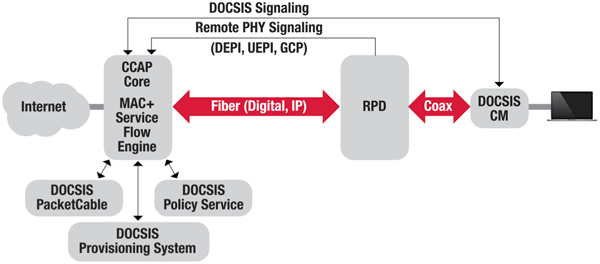Show Me The Money!
By Brady S. Volpe
Remote-PHY and Full Duplex DOCSIS
Doesn’t the cable industry just love initialisms and acronyms? Just as you thought you were getting your mind around DOCSIS 3.1 the industry continues to move forward and drop a bunch more terms like remote PHY (R-PHY) and full duplex (FDX) DOCSIS. I like soup, but we need a decoder ring for the alphabet soup we are eating. Don’t get me wrong, this is great stuff and awesome technology. CableLabs recently updated the DOCSIS 3.1 PHY specification to include FDX. This new addition to the alphabet soup packs some very powerful technology allowing us to push the limits of high speed over coax even further, getting more dBs (dollar bills) out of our existing investment — cha ching!
But this article is not about about FDX, instead it focuses on a key enabler of FDX, which is R-PHY. Without R-PHY, FDX would be — well rather a non-starter due to diplex filters and analog optics — all of which R-PHY handily makes go away. This article focuses on R-PHY, its benefits and how it works. FDX DOCSIS leverages R-PHY to achieve 10 Gbps symmetrical speeds in the HFC plant. One technology builds upon the other, so it is important that we lay the foundation of R-PHY so that everyone is on the same page.
Why R-PHY
Before we talk about how R-PHY works, we should first understand why R-PHY is beneficial and even something worth looking at. In today’s DOCSIS and video networks, all data signals — be they data or video — originate at the headend as Internet Protocol (IP) traffic. IP data traffic is sent into a CMTS and converted into QAM channels while IP video traffic is sent into a quadrature amplitude modulation (QAM) modulator. In the case of a converged cable access platform (CCAP)-enabled device, both IP data and video traffic can be sent to the CCAP and both are transformed into their respective single carrier (SC)-QAM signals or possibly DOCSIS 3.1 orthogonal frequency division multiplexed (OFDM) signals. In both cases these are RF signals and can be distributed on the HFC plant by analog optical transmitters and receivers to a fiber node somewhere far away.
IP data from the subscribers is returned to the CMTS or CCAP as RF signals on the upstream. The upstream RF signals from the coax plant are received at the node and transmitted to the headend or hub where they are converted back to IP data and sent on its way to the Internet.
Notice how frequently the IP data has passed through analog optical systems. I’ve penned many articles and podcasts where I discussed how the upstream and in particular the return path optical transmitter is the “Achilles Heel” of the DOCSIS network. Return path transmitters cause many non-linear distortions, the most notable of which is laser clipping due to too much RF power at the input of the optical transmitter. These problems only get worse as we add more upstream signals driven by more data demands by our subscribers. The downstream will have the same problem as we expand our RF spectrum to 1.2 GHz and beyond to support more data requirements, not to mention the complexities of headend cabling and combining required.
Wouldn’t it be great to completely eliminate analog optics altogether? This is possible with R-PHY. In addition R-PHY pushes all-IP to the fiber node (data and video). It is at the fiber node where IP is converted to SC-QAM or OFDM signals — very high quality signals in fact. Similarly, upstream data from the subscribers is converted from RF to IP for transport back to the headend. No more analog! But how is it done?
How R-PHY Works
The architecture for remote PHY is defined with a modular CMTS as shown in Figure 1. This is pulled from the CableLabs CM-SP-R-PHY-I08-170908 R-PHY specification, section 5.3.1 and will be referenced throughout this article.

Figure 1. R-PHY Reference Architecture
Starting from left to right, one should see the familiar CCAP core. This is the standard CCAP you likely have in your headend today — maybe even the shiny new DOCSIS 3.1 CCAP you’ve recently installed. However your CCAP is currently generating SC-QAM or OFDM signals and transmitting them via analog fiber optics to the HFC plant.
Notice in Figure 1 that the CCAP core is connected to a remote PHY device (RPD) via a fiber link. The RPD is intentionally left generic in the specification so that vendors have flexibility in their design. However, most vendors are standardizing on their designs for interoperability, which many of us saw at Cable-Tec Expo 2017.
The fiber connection between the CCAP core and the RPD is essentially a high speed optical Ethernet connection (think 10 Gbps speeds or higher), which sends the IP data and video to the RPD. The RPD then converts the IP data and video signals to SC-QAM and/or OFDM signals suitable for transmitting on the coaxial network. Notice I did not say HFC network because once at the RPD we are in a fiber node. This is the demarcation between the fiber and the coax — or the F and C in HFC. In summary, the R-PHY architecture has provided a high speed digital optical link between the CCAP and the fiber node. All analog optics are gone!
Again referring to Figure 1, consider the return path from the subscriber. Data is transmitted as RF from the cable modem over the coax network. Once it arrives at the RPD it is converted to IP data. The IP data is now transmitted as digital IP over the high speed digital optic link to the CCAP. Again, no analog optical return — no more laser clipping!
There are a number of ancillary protocols that are also transmitted over the digital optical link which add to the alphabet soup, such as DEPI (downstream external PHY interface), UEPI (upstream external PHY interface) and more, but I’ll leave it up to the reader to investigate the details of these protocols if you are interested.
Future of R-PHY
I’m really excited about R-PHY for a number of reasons. First off it extends your existing investment in DOCSIS 3.1 CCAP technology — so don’t fear, that new purchase you recommended now has even more life in it. Vendors will enable you to connect your CCAP core to an R-PHY shelf or node, but how is this a benefit? First off we are eliminating all analog optics and pushing digital closer to the subscriber — that alone is huge plus. Next, consider you that you have pushed that 10 Gbps or 100 Gbps digital optical pipe to the fiber node… now you are no longer sharing downstream QAM signals with multiple fiber nodes. Similarly, we have completely eliminated return path ingress funneling back at the headend. Upstream demodulation can happen at the RPD.
The RPD is also a perfect size to be installed into MDUs. I’ve all too often seen operators use low-cost CMTSs with a video overlay for MDU environments. R-PHY is a perfect replacement for this to use existing headend infrastructure and does not require the video overlay.
Over time I am confident that the technology that has already made the RPD small enough to fit into a fiber node can further be extended so that the RPD could be made to fit in smaller devices such as a mainline tap. This would open up tremendous potential to aggressively fend off any telecom competitor without the requirement to pull fiber to the home. Need 10 Gbps to an office or neighborhood? No problem, just start populating taps with the new low-cost R-PHY RPD tap devices (R-TAPs) and every subscriber can now experience blazingly fast speed over coax — without the high expensive of digging up a lawn or flower bed.
Brady Volpe is Founder of The Volpe Firm, Inc and Nimble This LLC. He has nearly 25 years of broadband cable and telecommunications industry experience specializing in RF, DOCSIS, PNM, and Internet Protocol. Mr. Volpe has been providing a wide range of troubleshooting, design solutions, services and seminars for cable operators and broadband companies specializing in DOCSIS, System Design, PNM, and Troubleshooting. He is a highly respected published speaker, both domestically and internationally. Mr. Volpe holds a BSEE and a MSEE.
Credit: Artwork by Mia Colabrese






Pingback: Remote-PHY Full Duplex DOCSIS | Blazingly Fast Speed Over Coax